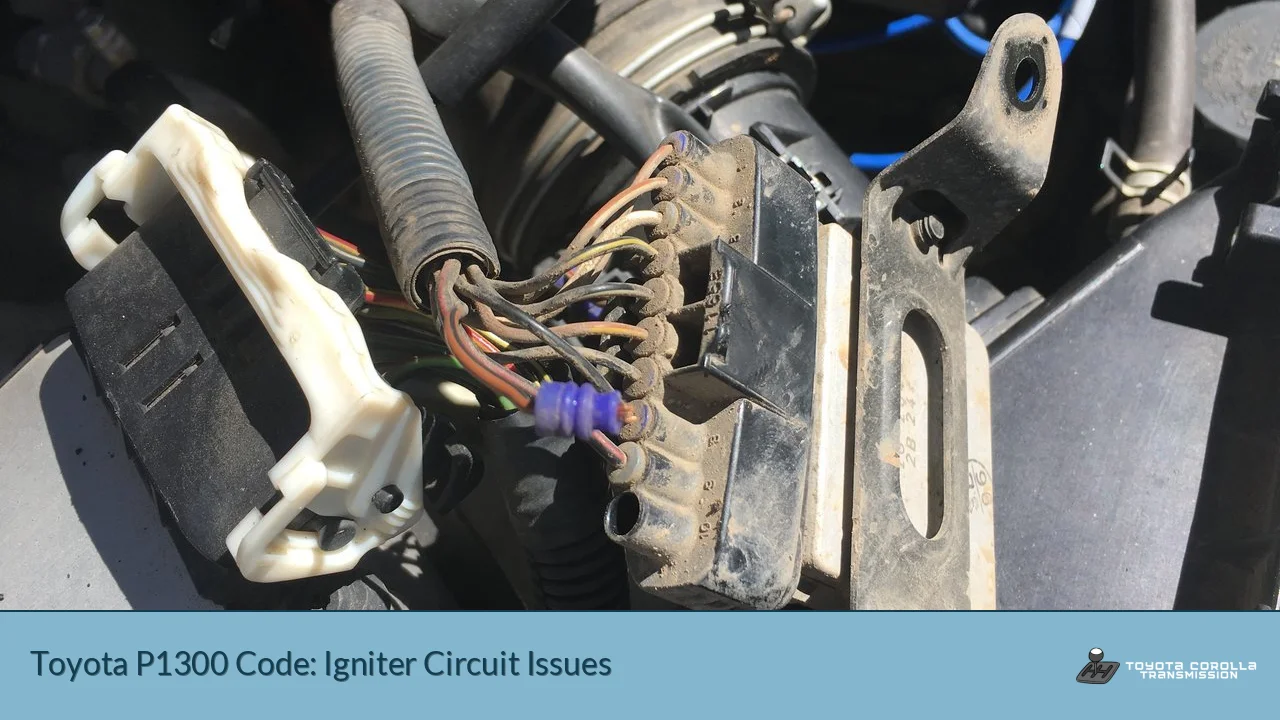The P1310 Toyota error code indicates an ignition control circuit malfunction in cylinder 3. This diagnostic trouble code (DTC) is specific to Toyota vehicles and points to issues with the ignition system, particularly affecting the third cylinder. When this code appears, it suggests a problem with the igniter circuit, potentially impacting engine performance and fuel efficiency.
| Aspect | Details | Possible Causes |
|---|---|---|
| Code Definition | Ignition control – cylinder No. 3 – circuit malfunction | Faulty ignition coil, damaged wiring, ECM issues |
| Severity | Moderate to High | Can lead to engine misfires and reduced performance |
| Common Symptoms | Engine misfires, rough idle, reduced power | Poor fuel economy, difficulty starting |
Understanding the P1310 Code
The P1310 code is set when the Engine Control Module (ECM) detects an abnormality in the ignition system of cylinder 3. Specifically, it indicates that the ECM is not receiving the expected Ignition Feedback (IGF) signal from the igniter after sending an Ignition Timing (IGT) signal. This discrepancy suggests a malfunction in the ignition circuit for the third cylinder.
Ignition System Components
To fully grasp the implications of the P1310 code, it’s crucial to understand the key components involved:
- Ignition Coil: Transforms low voltage from the battery into high voltage needed for spark plugs.
- Igniter: Acts as a switch to control the primary current in the ignition coil.
- ECM: Manages the ignition timing and monitors the system’s performance.
- Wiring Harness: Connects all components and carries electrical signals.
The Role of IGT and IGF Signals
The ignition system’s functionality relies heavily on two critical signals:
- IGT (Ignition Timing) Signal: Sent from the ECM to the igniter, instructing when to fire the spark plug.
- IGF (Ignition Feedback) Signal: Returned from the igniter to the ECM, confirming that the ignition event occurred.
When the P1310 code is triggered, it means the ECM is not receiving the expected IGF signal from cylinder 3, indicating a breakdown in this communication loop.
Common Causes of P1310
Several factors can contribute to the P1310 code appearing:
- Faulty Ignition Coil: A defective coil may not produce the necessary high voltage.
- Damaged Wiring: Broken or corroded wires can interrupt signal transmission.
- Igniter Malfunction: A faulty igniter might not properly control the coil or send feedback.
- ECM Issues: Though less common, ECM problems can lead to misinterpretation of signals.
- Corroded Connectors: Poor electrical connections can disrupt signal flow.
Diagnosing P1310
Proper diagnosis is crucial for effectively addressing the P1310 code. Here’s a step-by-step approach:
- Visual Inspection: Check for obvious signs of damage to wiring or components.
- Resistance Testing: Measure the resistance of the ignition coil and compare to specifications.
- Voltage Testing: Verify proper voltage supply to the ignition components.
- Oscilloscope Analysis: Examine IGT and IGF signals for abnormalities.
- Component Swapping: If possible, swap the ignition coil with a known good one from another cylinder.
Using Diagnostic Tools
Modern OBD-II scanners can provide valuable data for diagnosing P1310. Look for:
- Freeze Frame Data: Captures engine conditions when the code was set.
- Live Data: Monitors real-time ignition system performance.
- Misfire Counts: Identifies which cylinders are experiencing issues.
Fixing P1310
Once the root cause is identified, the following steps may resolve the P1310 code:
- Replace Ignition Coil: If faulty, install a new coil for cylinder 3.
- Repair Wiring: Fix any damaged or corroded wires in the ignition circuit.
- Clean Connections: Remove corrosion from connectors and ensure tight fits.
- Update ECM Software: In some cases, a software update may resolve communication issues.
- Replace Igniter: If separate from the coil, a faulty igniter may need replacement.
Preventive Measures
To avoid future occurrences of P1310:
- Regular Maintenance: Follow the manufacturer’s recommended service schedule.
- Quality Parts: Use OEM or high-quality aftermarket components.
- Protect Wiring: Shield ignition system wiring from heat and physical damage.
Impact on Vehicle Performance
The P1310 code can significantly affect your Toyota’s performance:
- Reduced Power: Misfires in cylinder 3 can lead to noticeable power loss.
- Poor Fuel Economy: Incomplete combustion wastes fuel and reduces efficiency.
- Rough Idle: Inconsistent firing can cause the engine to run unevenly at idle.
- Difficulty Starting: In severe cases, the engine may be hard to start or fail to start.
Long-term Consequences
Ignoring the P1310 code can lead to more serious issues:
- Catalytic Converter Damage: Unburned fuel can overheat and damage the converter.
- Increased Emissions: Misfires can cause the vehicle to fail emissions tests.
- Engine Wear: Prolonged misfiring can cause uneven wear on engine components.
FAQs
What does the P1310 code mean for my Toyota?
P1310 indicates an ignition control circuit malfunction in cylinder 3. It suggests issues with the ignition coil, wiring, or related components.
Can I drive with the P1310 code?
While possible, it’s not recommended. Driving with P1310 can cause poor performance, reduced fuel efficiency, and potential engine damage.
How much does it cost to fix P1310?
Repair costs vary but typically range from $100 to $500, depending on the cause and whether professional diagnosis is needed.
Will P1310 clear itself?
P1310 rarely clears on its own. It usually requires fixing the underlying issue and clearing the code with a scan tool.
Is P1310 related to other ignition codes?
Yes, P1310 is often related to other ignition codes like P0300 (random misfire) or cylinder-specific misfire codes.

